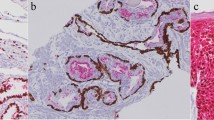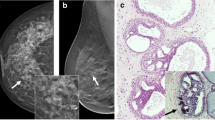Abstract
Background
Current American Thyroid Association (ATA) guidelines state that patients with intermediate-risk papillary thyroid cancer (PTC) may benefit from remnant ablation. One criterion for intermediate-risk classification is >5 positive lymph nodes (LNs). We investigate whether performing step-sectioning of LNs increases the metastatic detection rate, thereby influencing ATA risk of recurrence (ROR) classification.
Methods
A retrospective review was conducted of cases in which ≥ 5 LNs were removed during thyroidectomy and ≤5 LNs were found positive for PTC. Step-sectioning was performed on the original tissue blocks. All slides were re-reviewed by a senior pathologist.
Results
Twenty patients met study criteria. Step-sectioning significantly increased LN yield compared to standard sectioning. In total, we found 12 new positive lymph nodes; seven (58%) were in totally new lymph nodes, while five (42%) were in lymph nodes previously read as negative. All newly discovered metastases were classified as micrometastases (≤2 mm). Of the 15 patients originally classified as low-risk, the step-sectioning protocol impacted two patients (13%), increasing ROR stratification.
Conclusion
Intensive step-sectioning reveals additional micrometastases. More detailed analysis did not identify clinically significant nodal disease likely to impact the clinical course of patients in this study. Our study supports current standards of pathology specimen handling related to LN assessment and the impact on ATA ROR classification. Nonetheless, it is important for clinicians to understand their institution’s sectioning protocol utilized to report positive and total LN counts, which could impact ATA risk stratification and denote the comprehensive nature of the LN dissection that was performed.




Similar content being viewed by others
References
Ito Y, Jikuzono T, Higashiyama T et al (2006) Clinical significance of lymph node metastasis of thyroid papillary carcinoma located in one lobe. World J Surg 30:1821–1828. https://doi.org/10.1007/s00268-006-0211-5
Randolph GW, Duh QY, Heller KS et al (2012) The prognostic significance of nodal metastases from papillary thyroid carcinoma can be stratified based on the size and number of metastatic lymph nodes, as well as the presence of extranodal extension. Thyroid 22:1144–1152
Sugitani I, Kasai N, Fujimoto Y et al (2004) A novel classification system for patients with PTC: addition of the new variables of large (3 cm or greater) nodal metastases and reclassification during the follow-up period. Surgery 135:139–148
Haugen BR, Alexander EK, Bible KC et al (2016) 2015 American Thyroid Association management guidelines for adult patients with thyroid nodules and differentiated thyroid cancer: the American Thyroid Association guidelines task force on thyroid nodules and differentiated thyroid cancer. Thyroid 26:1–133
Hong YR, Lee SH, Lim DJ et al (2017) The stratification of patient risk depending on the size and ratio of metastatic lymph nodes in papillary thyroid carcinoma. World J Surg Oncol 15:74
Cranshaw IM, Carnaille B (2008) Micrometastases in thyroid cancer. An important finding? Surg Oncol 17:253–258
Pathology AoDoAS (2001) Recommendations for processing and reporting of lymph node specimens submitted for evaluation of metastatic disease. Am J Clin Pathol 115:799–801
Calhoun BC, Chambers K, Flippo-Morton T et al (2014) Breast cancer detection in axillary sentinel lymph nodes: the impact of the method of pathologic examination. Hum Pathol 45:2497–2501
Maguire A, Brogi E (2016) Sentinel lymph nodes for breast carcinoma: a paradigm shift. Arch Pathol Lab Med 140:791–798
Weaver DL (2010) Pathology evaluation of sentinel lymph nodes in breast cancer: protocol recommendations and rationale. Mod Pathol 23(Suppl 2):S26–S32
Dobrinja C, Troian M, Cipolat Mis T et al (2017) Rationality in prophylactic central neck dissection in clinically node-negative (cN0) papillary thyroid carcinoma: is there anything more to say? A decade experience in a single-center. Int J Surg 41(Suppl 1):S40–S47
Giordano D, Frasoldati A, Gabrielli E et al (2017) Long-term outcomes of central neck dissection for cN0 papillary thyroid carcinoma. Am J Otolaryngol 38:576–581
Riber-Hansen R, Hastrup N, Clemmensen O et al (2012) Treatment influencing down-staging in EORTC Melanoma Group sentinel node histological protocol compared with complete step-sectioning: a national multicentre study. Eur J Cancer 48:347–352
Haglund F, Garvin S, Ihre-Lundgren C et al (2016) Detailed lymph node sectioning of papillary thyroid carcinoma specimen increases the number of pN1a patients. Endocr Pathol 27:346–351
Acknowledgements
The authors wish to thank Jill Gregory for the artwork and the Mount Sinai Health System for its generous support of this research project.
Author information
Authors and Affiliations
Corresponding author
Ethics declarations
Conflict of interest
Dr. Urken is the Medical Advisor of the THANC Foundation. No other potential conflict of interest relevant to this article exists.
Additional information
Publisher's Note
Springer Nature remains neutral with regard to jurisdictional claims in published maps and institutional affiliations.
Disclaimer Initial results of this paper were presented at the American Thyroid Association (ATA) Conference in Victoria, BC, Canada from October 18-22, 2017.
Rights and permissions
About this article
Cite this article
Griffin, M.J., Baik, F.M., Brandwein-Weber, M. et al. Positive Lymph Node Counts in American Thyroid Association Low-Risk Papillary Thyroid Carcinoma Patients. World J Surg 44, 1892–1897 (2020). https://doi.org/10.1007/s00268-020-05399-0
Published:
Issue Date:
DOI: https://doi.org/10.1007/s00268-020-05399-0




